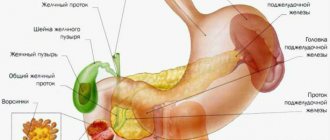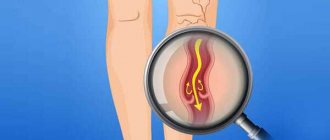The urethra (urethra) is part of a woman's urinary system and a man's urinary and reproductive systems.
In men, the 20 cm long urethra is located both in the pelvis and inside the penis, and opens into an external opening on the glans. Anatomically, the following sections of the male urethra are distinguished: (1) external opening; (2) scaphoid fossa; (3) penile; (4) bulbous; (5) membranous; (6) prostatic (proximal and distal areas).
Figure taken from www.urologyhealth.org
The prostatic urethra passes through the prostate and is divided into proximal and distal parts at the level of the seminal tubercle. In the proximal part of the prostatic urethra, the excretory ducts of the prostatic glands open at the orifices along the posterolateral surfaces. On the sides of the seminal tubercle are the mouths of the right and left ejaculatory ducts, through which sperm enters the lumen of the urethra from the seminal vesicles and vas deferens. In the distal part of the prostatic part and in the membranous part of the urethra there are elements of the urethral sphincter. Starting from the bulbar region, the urethra passes inside the corpus spongiosum of the penis. The bulbar region is located inside the bulb of the corpus spongiosum. In the membranous and bulbar sections, the urethra bends anteriorly upward. In the penile region, the urethra is located medially along the ventral surface of the penis downward from the cavernous bodies. The capitate part of the urethra is located inside the head of the penis. The inner surface of the male and female urethra is covered with mucous membrane (transitional epithelium, with the exception of a short area near the external opening, where there is flat non-keratinizing epithelium).
What is the urinary system and how does it work?
The urinary tract is a continuous system of hollow organs whose main function is the production, collection, transportation, storage and excretion of urine.
The urinary system is divided into upper and lower sections. The upper urinary system consists of the kidneys and a tube called the ureter, which transports urine from the kidney to the bladder.
The lower urinary system consists of the bladder and another tube called the urethra, which ends the urinary system and transports urine from the bladder to the outside.
The function of the urinary system is to ensure the removal of metabolic products from the human body, regulate water-salt balance, and also store and transport urine.
The urinary system works in conjunction with the lungs, skin and intestines to maintain the balance of chemicals and water in the body. Adults excrete from 800 to 2000 milliliters of urine per day with normal drinking water consumption per day, which is 1.5-2 liters. Several factors influence the increase in urine production in the body. For example, certain types of medications, such as diuretics (water medications), are sometimes used to treat high blood pressure. Drinks such as coffee and alcohol can also cause an increase in the amount of urine produced in some people.
Diagnostics
Diagnostic measures are carried out by a urologist. If necessary, patients are referred to an andrologist, gynecologist or oncologist. The specialist collects complaints, ascertains the life history, establishes the circumstances of the appearance and nature of the painful sensations, the presence of other symptoms, and the dynamics of the development of the disease. Women are examined on a chair. For men, according to indications, digital examination of the rectum is prescribed. The diagnostic plan includes the following procedures:
- Ultrasonography.
Ultrasound of the urethra is informative for injuries, diverticula, foreign bodies, tumors, and stones. To obtain more complete data on the condition of the urinary tract and to exclude damage to the overlying sections, an ultrasound scan of the bladder is prescribed. Women undergo an ultrasound of the pelvic organs. Men undergo an ultrasound of the prostate. - X-ray examination.
Retrograde urethrography is recommended for traumatic injuries, diverticulitis, benign and malignant neoplasia, and stones. In some cases, descending urethrography, excretory urography, prostatography, cystography, and pelvic radiography are indicated. - Other visualization techniques.
Mainly used for malignant tumors. They are carried out to clarify the localization and extent of the pathological process and the involvement of neighboring organs. The list of diagnostic procedures may include MRI of the abdominal cavity, lymphadenography, etc. - Lab tests.
The most revealing tests are urine tests. Leukocyturia, hematuria, bacteriuria, and proteinuria can be detected in TAM. Based on the data from a three-glass sample, the level of damage is determined. The nature of the microflora is assessed by microscopy. To clarify the type of pathogen and its sensitivity to antibiotics, a microbiological study is carried out. For STIs, PCR and ELISA are prescribed. The type and degree of differentiation of neoplasia is determined during histological analysis.
Upper urinary system
Kidneys
The kidneys are a paired organ, they are located on both sides of the spine in the retroperitoneal space just above the lumbar region and have the appearance of a large bean and are approximately the size of a fist. The right kidney is located slightly lower than the left due to the position of the liver. In an adult, the average kidney is 10 cm long, 6 cm wide and 3 cm thick, and weighs about 120-200 g. The left one is usually slightly larger than the right kidney.
Each kidney is covered by a fibrous capsule that protects the kidney from injury. All pain sensations are associated with this capsule: the organ itself has no pain receptors. When the capsule is damaged or stretched, pain of varying nature and intensity appears.
Kidney tissue or parenchyma consists of outer (cortical) and inner (medullary) layers.
Blood enters the kidney through the renal artery (a branch of the aorta) and is filtered through the microscopic structural working units of the kidney, the nephrons. Each kidney contains about a million nephrons. Their job is to filter blood and produce urine. Each nephron consists of a ball formed by small blood capillaries (the glomerulus), surrounded by a dome-shaped structure, the glomerular capsule (or Bowman's capsule), and a small tube called the renal tubule. Here, the blood plasma is filtered, which leads to the formation of urine.
The urine storage system consists of small renal calyces, which, merging with each other in 2-3 groups, form a large renal calyx, and these in turn form the renal pelvis. The renal pelvis passes directly into the ureter.
All functions normally performed by two kidneys can be adequately performed by one healthy kidney. Some people are born with only one kidney, while others choose to donate one kidney for transplantation into a person with kidney failure.
Basic kidney function
is to maintain the correct balance of water and minerals (including electrolytes) in the body.
An important function of the kidneys is to regulate fluid balance by excreting excess water in the form of urine while maintaining the required amount of water in the body, which is necessary for life. When the kidneys lose their ability to remove excess water, edema appears.
The kidneys regulate the balance of minerals and substances such as sodium, potassium, calcium, phosphorus, magnesium and bicarbonate and maintain normal blood composition. Changes in sodium levels can affect a person's mental state, while changes in potassium levels can have serious adverse effects and cause problems with the heart and muscle function. Maintaining normal levels of calcium and phosphorus is essential for healthy bones and teeth.
Additional functions of the kidneys include:
- Filtration and removal from the body of food processing waste, medications and harmful substances (toxins).
- Creatinine and urea are two important byproducts of kidney function that can be easily measured in the blood. Their values in blood tests reflect kidney function. When kidney problems occur, creatinine and urea levels increase.
- Regulate Blood Pressure – The kidneys produce various hormones (renin, angiotensin, aldosterone, prostaglandins, etc.) that help regulate the amount of water and salt, the levels of which play a vital role in maintaining blood pressure. Impaired hormone production and salt and water regulation in a patient with, for example, kidney failure can lead to high blood pressure.
- Blood volume regulation
- Regulating blood pH
- Converts vitamin D into its active form, which is necessary for the absorption of calcium from food, growth of bones and teeth, and maintenance of their health. Decreased levels of active vitamin D lead to decreased bone growth rates. Slow growth may be a sign of kidney disease in children.
Erythropoietin
is a hormone produced in the kidneys and plays an important role in the production of red blood cells. With kidney failure, the production of erythropoietin decreases, which in turn leads to a decrease in hemoglobin levels (anemia). This is the reason why the hemoglobin count does not improve in patients with kidney failure despite taking iron supplements and vitamins.
Ureters
These are fibromuscular tubes that drain urine from the renal pelvis to the bladder and are about 25-30 cm long and 6-8 mm wide. They enter the bladder from behind and at an angle, ending in the lumen of the bladder in the form of holes - the mouth of the ureters. The lower ureter is compressed by the bladder wall passively during urine storage and dynamically during voiding. Essentially, it is a valve that prevents vesicoureteral reflux (i.e., stops urine from flowing back into the kidneys). The wall of the ureter is made up of three layers, including a layer of muscle that helps it contract and move urine from the kidney to the bladder. Small portions of urine enter the bladder from the ureters approximately every 10-15 seconds.
Along the length of the ureter there are three physiological narrowings: at the level of the transition of the pelvis to the ureter, the place of intersection with the common iliac vessels and in the thickness of the bladder wall. With urolithiasis, stones can get stuck in places where the ureters are narrowed, causing renal colic.
How is blood purified and urine formed?
Healthy kidneys filter about 100 ml of blood every minute, removing waste and extra water to eventually form urine.
There are three main stages of urine formation:
- filtration
- reabsorption
- secretion
In the process of purifying the blood, the kidneys retain all the necessary substances and selectively remove excess fluid and waste from the body.
- per day, the kidneys produce 140-180 liters of primary urine; in 24 hours, all circulating blood is cleansed several times; with age, these processes slow down
- the purification process takes place in small filter units known as nephrons.
- each kidney contains about a million nephrons, and each nephron consists of glomeruli and tubules.
- glomeruli are filters with very small pores, characteristic of selective filtration. Water and small substances are easily filtered through them. But larger red blood cells, white blood cells, platelets, protein, etc. cannot pass through these pores. Therefore, such cells are usually not visible in the urine of healthy people.
- The first stage of urine formation occurs in the glomeruli, where urine is filtered in an amount of 100-125 ml per minute, thus 140-180 liters of primary urine are formed in 24 hours. It contains not only industrial waste and toxic substances, but glucose and other useful substances.
- Each kidney performs the process of reabsorption (reabsorption). Of the fluid entering the tubules, 99% of the fluid is selectively reabsorbed and only the remaining 1% of the fluid is excreted as secondary urine. Thanks to this process, all the necessary substances are reabsorbed in the tubules, while 1-2 liters of fluid containing waste and other harmful substances are excreted from the body in the form of secondary urine.
Thus, the kidneys have filtration and concentration abilities.
Can there be a change in urine volume in a person with healthy kidneys?
YES. The amount of water consumed and atmospheric temperature are the main factors that determine the volume of urine that a normal person excretes.
Depending on the amount of fluid consumed, the amount of urine excreted changes: the more fluid enters the body, the more it is excreted and the less concentrated the urine, its color becomes light, even transparent. If the amount of fluid decreases, then the amount of urine excreted becomes less, it will be more concentrated, and the color will be dark straw.
During the summer months, sweating caused by high ambient temperatures causes urine volume to decrease. During the winter months the opposite is true - low temperatures, lack of sweating and more urine.
In a person with normal water intake, if the urine volume is less than 500 ml or more than 3000 ml, this may indicate that the kidneys need more attention and additional examination.
Make an appointment
Make an appointment with a gynecologist by calling 8(812)952-99-95 or filling out the online form - the administrator will contact you to confirm your appointment
guarantees complete confidentiality
Lower urinary system
Bladder
The bladder is a hollow muscular organ that serves as a reservoir for urine, located just behind the pubic bone. In men, the seminal vesicles, vas deferens, ureters and rectum are adjacent to the bladder at the back. In women, the uterus and proximal vagina are located between the bladder and rectum.
The volume of the bladder can vary significantly depending on how full it is. The physiological capacity of the bladder is on average 250–350 ml, the anatomical capacity is up to 1000 ml.
The wall of the bladder is represented by: mucosa, submucosa, muscular and outer adventitia. The serous membrane lines only the bottom of the bladder.
The mucous membrane of the bladder has the ability to remain intact in the presence of urine, a rather aggressive liquid, in the bladder.
The bladder consists of an apex, body, bottom and lower narrow part - the neck. At the bottom of the bladder is a triangular area known as the vesical triangle or Lieto's triangle. Urine enters the bladder from the ureters at the very top of the triangle and leaves the bladder through the urethra at the very bottom.
The bladder neck is a funnel-shaped extension at the bottom of the bladder, which then connects to the urethra. It is 2-3 cm long and forms a muscular band around the urethra known as the internal sphincter. The sphincter is usually tightly closed and prevents urine from leaking from the bladder. When a person decides to release urine, the sphincter relaxes and urine flows from the bladder into the urethra.
Male urethra
In men, the urethra is a tube 15–22 cm long, starting from the neck of the bladder and ending with the external opening on the head of the penis (meatus). The urethra in men has the function of transporting urine and releasing ejaculate, which enters through the vas deferens.
The male urinary canal consists of several sections:
- The prostatic part passes through the prostate gland, its length is 3–4 cm, in this part of the urethra the seminal tubercle is located, the vas deferens and the prostate ducts open.
- The membranous (membranous) part of the urethra is a section from the apex of the prostate gland to the bulb of the penis, its length is 1.5–2 cm. The membranous part of the urethra is surrounded by striated muscle bundles of the sphincter.
- The spongy or penile part of the urethra passes inside the spongy body of the penis, opens at the head with an external opening, its length is about 15 cm.
The mechanism of urinary continence involves two sphincters: internal (1) and external (2). The internal sphincter is located on the border between the neck of the bladder and the beginning of the prostatic urethra, the external sphincter is located in front of the seminal tubercle.
Female urethra
The female urethra is much shorter than the male urethra and is only 4 cm in length. Urine leaves the body through the opening in the urethra, which is located above the opening of the vagina.
Treatment
Conservative therapy
The list of therapeutic measures is determined by the characteristics of the pathological process:
- Urethritis.
For acute nonspecific and gonorrheal urethritis, antibiotics are prescribed; for chlamydia, antibacterial therapy is supplemented with corticosteroids; for trichomoniasis, antiprotozoal agents are used; for candidiasis, antimycotic agents are used. Chronic inflammation is an indication for complex therapy, which, along with the listed drugs, includes instillation of silver nitrate and collargol. - Injuries and foreign bodies.
Sprains and bruises of the urethra are subject to conservative treatment. Cold, rest, NSAIDs, hemostatic agents, tranquilizers, sedative medications, and prophylactic antibiotic therapy are recommended. Small foreign objects are sometimes successfully removed with urine flow using special techniques. - Prolapse of the mucous membrane.
Warm sitz baths are used to relieve swelling. In mild cases, catheterization of the bladder is performed for a period of 10-12 days. Manipulation allows not only to straighten the urethra, but also to fix the mucous membrane, preventing further prolapse. - Prostatitis.
Long-term antibiotic therapy is carried out; if the course persists, immunostimulants are used. Non-drug measures include prostate massage, electromagnetic vibrations, ultrasound, laser exposure. If there are contraindications to physiotherapy, medicinal microenemas are given. - Malignant tumors
. Chemotherapy, external beam or contact radiation therapy may be required.










